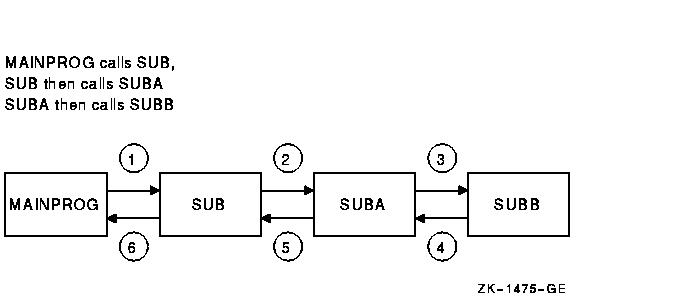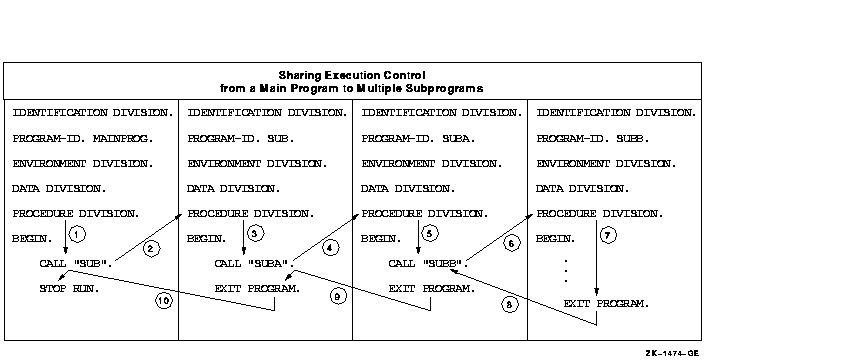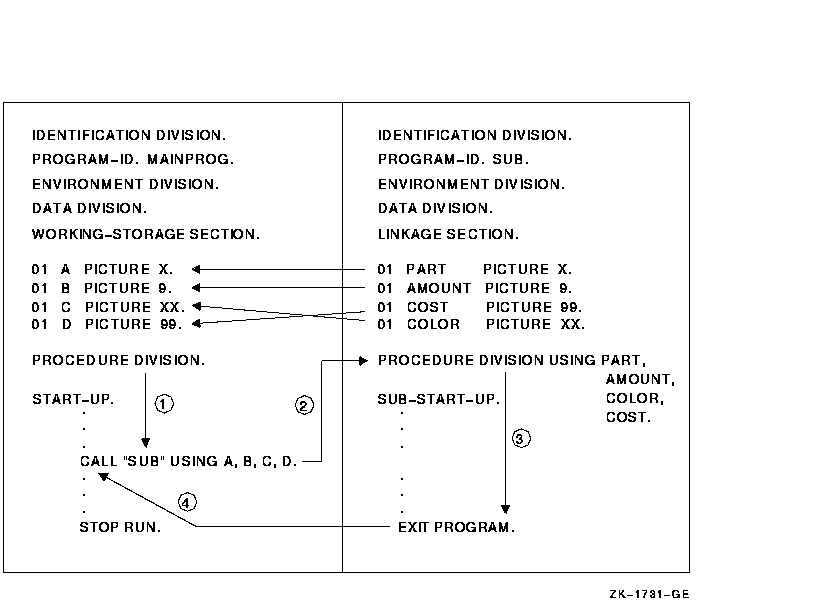IDENTIFICATION DIVISION. IDENTIFICATION DIVISION.
PROGRAM-ID. MAIN-PROGRAM. (1) PROGRAM-ID. SUB1. (2)
. .
. .
. .
CALL SUB1. CALL SUB2.
. .
. .
. .
STOP RUN. EXIT PROGRAM.
END PROGRAM MAIN-PROGRAM END PROGRAM SUB1.
IDENTIFICATION DIVISION.
PROGRAM-ID. SUB2. (3)
.
.
.
EXIT PROGRAM.
END PROGRAM SUB2.
|
A separately compiled program has a nesting level number of 1. If this program contains other source programs, it is the outermost containing program. A contained program has a nesting level number greater than 1. |
Example 12-2 shows a run unit with one main program ((4)) and two contained programs (SUB1 ((5)) is a directly contained program of MAIN-PROGRAM; SUB2 ((6)) is an indirectly contained program of MAIN-PROGRAM).
| Example 12-2 Run Unit with a Main Program and Two Contained Programs |
|---|
IDENTIFICATION DIVISION.
PROGRAM-ID. MAIN-PROGRAM. (4)
.
.
.
CALL SUB1.
.
.
.
STOP RUN.
IDENTIFICATION DIVISION.
PROGRAM-ID. SUB1. (5)
.
.
.
CALL SUB2.
EXIT PROGRAM.
IDENTIFICATION DIVISION.
PROGRAM-ID. SUB2. (6)
.
.
.
EXIT PROGRAM.
END PROGRAM SUB2.
END PROGRAM SUB1.
END PROGRAM MAIN-PROGRAM.
|
Example 12-3 shows a run unit with three separately compiled programs ((7), (10), and (11)). One of the separately compiled programs, MAIN-PROGRAM ((7)), has two directly contained programs, SUB1 and SUB2 ((8) and (9)).
| Example 12-3 Run Unit with Three Separately Compiled Programs, One with Two Contained Programs |
|---|
IDENTIFICATION DIVISION.
PROGRAM-ID. MAIN-PROGRAM. (7)
.
.
.
CALL SUB1.
CALL SUB2.
.
STOP RUN.
IDENTIFICATION DIVISION.
PROGRAM-ID. SUB1. (8)
.
.
.
CALL SUB3.
EXIT PROGRAM.
END PROGRAM SUB1.
IDENTIFICATION DIVISION.
PROGRAM-ID. SUB2. (9)
.
.
.
EXIT PROGRAM.
END PROGRAM SUB2.
END PROGRAM MAIN-PROGRAM.
IDENTIFICATION DIVISION.
PROGRAM-ID. SUB3. (10)
.
.
.
CALL SUB4.
.
.
.
STOP RUN.
IDENTIFICATION DIVISION.
PROGRAM-ID. SUB4. (11)
.
.
.
EXIT PROGRAM.
|
12.1.2 Calling Procedures
A COBOL main (driver) program calls subprograms (contained or separately compiled). Image execution begins and ends in the main program's Procedure Division. The program contains one or more CALL statements and is a calling program.
A COBOL subprogram is called by a main program or another subprogram. The subprogram may or may not contain CALL statements. If a subprogram contains a CALL statement, it is both a calling and a called program. If the subprogram does not contain a CALL statement, it is a called program only.
Special Code for Programs Called "main" (Tru64 UNIX)
On the Tru64 UNIX operating system, if you have a main program called main, that program preempts a COBOL Run-Time Library (RTL) initialization routine also called main. This RTL routine is needed to make a CALL data-name statement (or cobfunc, cobcall, cobcancel ) work correctly. Your program main must supply the necessary code by calling the cob_init routine in the RTL. The cob_init routine specification (in C) is as follows:
void cob_init ( /* init the RTL */
int argc, /* argument count */
char **argv, /* arguments */
char **envp /* environment variable pointers */
)
|
A Compaq COBOL program called MAIN will only interfere with main if it was compiled with the -names lowercase flag. |
12.2 COBOL Program Attributes
Any Compaq COBOL program can have the INITIAL clause in the
PROGRAM-ID paragraph. Data and files in a COBOL program can
have the EXTERNAL clause.
12.2.1 The INITIAL Clause
A COBOL program with an INITIAL clause is returned to its initial state whenever that program exits. This ensures that it will be in its initial state the next time it is called.
During this initialization process, all internal program data whose description contains a VALUE clause is initialized to that defined value. Any item whose description does not include a VALUE clause will be initialized, and contain an undefined value.
When an INITIAL clause is present and when the program is called, an implicit CLOSE statement executes for all files in the open mode associated with internal file connectors.
When an INITIAL clause is not present, the status of the files and internal program data are the same as when the called program was exited.
The initial attribute is attained by specifying the INITIAL clause in the program's PROGRAM-ID paragraph. For example:
IDENTIFICATION DIVISION. PROGRAM-ID. TEST-PROG INITIAL. |
12.2.2 The EXTERNAL Clause
Storage of data can be external or internal to the program in which the data is declared. A file connector can also be external or internal to the program in which it is defined.
External data or files can be referenced by every program in a run unit that describes that data or those files as external.
The EXTERNAL clause indicates that data or a file is external. This clause is specified only in File Description entries in the FILE SECTION or in Record Description entries in the WORKING-STORAGE Section. The EXTERNAL clause is one method of sharing data between programs. For example, in the following Working-Storage Section entry, the data items in RECORD-1 are available to any program in the image that also describes RECORD-1 and its data items as EXTERNAL:
01 RECORD-1 EXTERNAL.
03 ITEMA PIC X.
03 ITEMB PIC X(20).
03 ITEMC PIC 99.
|
EXTERNAL files and data must be described identically in all programs in which they are defined. |
12.3 Transferring Flow of Control
You control a multiple program run unit sequence by executing the following:
- A controlling CALL statement in the calling program (main or subprogram)
- An EXIT PROGRAM statement in the called subprogram
Contained COBOL programs have additional communication
mechanisms that are explained in Section 12.5.
12.3.1 The CALL Statement
A CALL statement transfers the run unit's flow of control from the calling program to the beginning of the called subprogram's Procedure Division. See the Compaq COBOL Reference Manual for the CALL statement format.
The first time the called subprogram gains the flow of control, it is in its initial state. Thereafter, each time it is called its state is the same as the last exit from that program, except when: (1) the called program has the INITIAL clause, or (2) the calling program cancels the called program.
A program cannot cancel itself nor can any program cancel the program that called it. |
In COBOL programs, to call a routine named SPECIALROUTINE from an overlying COBOL program you might use:
MOVE "SPECIALROUTINE" TO ROUTINE-NAME.
CALL ROUTINE-NAME.
|
If you need to call SPECIALROUTINE from a program in another language,
use
cobcall
or
cobfunc
.
12.3.2 Nesting CALL Statements
A called subprogram can itself transfer control flow after receiving control from a main program or another subprogram. This technique is known as CALL statement nesting. For example, Figure 12-1 shows a nested image that executes a series of three CALL statements from three separate programs.
Figure 12-1 Nesting CALL Statements

The MAINPROG, SUB1, and SUB2 programs in Example 12-4 illustrate their execution sequence by displaying a series of 12 messages on the default output device. Image execution begins in MAINPROG with message number 1. It ends in MAINPROG with message number 12. The image's message sequence is shown following the program listings.
| Example 12-4 Execution Sequence of Nested CALL Statements |
|---|
IDENTIFICATION DIVISION.
*
* MAINPROG is a calling program only
*
PROGRAM-ID. MAINPROG.
ENVIRONMENT DIVISION.
DATA DIVISION.
PROCEDURE DIVISION.
BEGIN.
DISPLAY " 1. MAINPROG has control first. ".
DISPLAY " 2. MAINPROG transfers control to SUB1 ".
DISPLAY " upon executing the following CALL. ".
CALL "SUB1"
DISPLAY "11. MAINPROG has control last. ".
DISPLAY "12. MAINPROG terminates the entire image upon ".
DISPLAY " execution of the STOP RUN statement. ".
STOP RUN.
IDENTIFICATION DIVISION.
*
* SUB1 is both a called and calling subprogram
*
* It is called by MAINPROG
*
* It then calls SUB2
PROGRAM-ID. SUB1.
ENVIRONMENT DIVISION.
DATA DIVISION.
PROCEDURE DIVISION.
BEGIN.
DISPLAY " 3. This is the entry point to SUB1. ".
DISPLAY " 4. SUB1 now has control. ".
DISPLAY " 5. SUB1 transfers control to SUB2. ".
CALL "SUB2"
DISPLAY " 9. SUB1 regains control ".
DISPLAY "10. after executing the following ".
DISPLAY " EXIT PROGRAM statement. ".
EXIT PROGRAM.
IDENTIFICATION DIVISION.
*
* SUB2 is called subprogram only
*
* It is called by SUB1
*
PROGRAM-ID. SUB2.
ENVIRONMENT DIVISION.
DATA DIVISION.
PROCEDURE DIVISION.
BEGIN.
DISPLAY " 6. This is the entry point to SUB2. ".
DISPLAY " 7. SUB2 now has control. ".
DISPLAY " 8. SUB2 returns control to SUB1 ".
DISPLAY " after executing the following ".
DISPLAY " EXIT PROGRAM statement. ".
EXIT PROGRAM.
END PROGRAM SUB2.
END PROGRAM SUB1.
END PROGRAM MAINPROG.
|
Example 12-5 shows the messages printed to the default output device when the programs in Example 12-4 are run.
| Example 12-5 Sequence of Messages Displayed |
|---|
1. MAINPROG has control first.
2. MAINPROG transfers control to SUB1
upon executing the following CALL.
3. This is the entry point to SUB1.
4. SUB1 now has control.
5. SUB1 transfers control to SUB2.
6. This is the entry point to SUB2.
7. SUB2 now has control.
8. SUB2 returns control to SUB1
after executing the following
EXIT PROGRAM statement.
9. SUB1 regains control
10. after executing the following
EXIT PROGRAM statement.
11. MAINPROG has control last.
12. MAINPROG terminates the entire image upon
execution of the STOP RUN statement.
|
12.3.3 The EXIT PROGRAM Statement
To return control to the calling program, the called subprogram executes an EXIT PROGRAM statement.
You can include more than one EXIT PROGRAM statement in a subprogram. However, if it appears in a consecutive sequence of imperative statements, the EXIT PROGRAM statement must appear as the last statement of the sequence. For example:
IF A = B DISPLAY "A equals B", EXIT PROGRAM.
READ INPUT-FILE AT END DISPLAY "End of input file"
PERFORM END-OF-FILE-ROUTINE
EXIT PROGRAM.
|
If you do not include an EXIT PROGRAM statement in a subprogram, the compiler generates one at the end of the program.
On executing an EXIT PROGRAM statement in a called subprogram, control returns to the statement following the calling program's CALL statement or the first imperative statement in a NOT ON EXCEPTION clause specified for that CALL statement.
On executing an EXIT PROGRAM statement in a main program, the EXIT PROGRAM is ignored and control continues with the next statement.
Figure 12-2 shows how control is passed between programs.
Figure 12-2 Transfer of Control Flow from a Main Program to Multiple Subprograms

12.4 Accessing Another Program's Data Division
In a multiple COBOL program run unit, a called subprogram can access some of its calling program's Data Division. The calling program controls how much of it will be accessible to the called subprogram in the following ways:
- The USING phrase in both the CALL statement and the Procedure Division header (see Section 12.4.1)
- The Linkage Section (see Section 12.4.2)
- The EXTERNAL clause (see Section 12.2.2)
- The GLOBAL clause (see Section 12.5.2)
12.4.1 The USING Phrase
To access a calling program's Data Division, use a CALL statement in the calling program and a Procedure Division USING phrase in the called program. The USING phrases of both the CALL statement and the Procedure Division header must contain an equal number of data names. (See Figure 12-3.)
Figure 12-3 Accessing Another Program's Data Division

In Figure 12-3, when execution control transfers to SUB, it can access the four data items in the calling program by referring to the data names in its Procedure Division USING phrase. For example, the data names correspond as follows:
| Data Name in MAINPROG (Calling Program) |
Corresponding Data Name in SUB (Called Subprogram) |
|---|---|
| A | PART |
| B | AMOUNT |
| C | COLOR |
| D | COST |
The CALL statement can make data available to the called program by the following argument-passing mechanisms:
- REFERENCE---The address of (pointer to) the argument (arg) is passed to the calling program. This is the default mechanism.
- CONTENT---The address of a copy of the contents of arg is passed to the called program. Note that since a copy of the data is passed, the called program cannot change the original calling program data.
- VALUE---The value of arg is passed to the called program. If arg is a data name, its description in the Data Division can be as follows: (a) COMP usage with no scaling positions (the PICTURE clause can specify no more than nine digits) and (b) COMP-1 usage.
- On OpenVMS, DESCRIPTOR---The address of (pointer to) the data
item's descriptor is passed to the called program. <>
(Note that BY DESCRIPTOR is not supported by Tru64 UNIX. See Compaq COBOL Reference Manual, the CALL statement.) - OMITTED---A value equivalent to BY VALUE 0 is passed to the called program. Note that OMITTED does not change the default mechanism.
A called COBOL subprogram must have arguments passed to it using BY REFERENCE, which is the default, or BY CONTENT. BY VALUE, OMITTED, and BY DESCRIPTOR are Compaq extensions and will not work as expected if passed to a COBOL program. These argument-passing mechanisms are necessary when calling Run-Time Library Routines and system service routines as described in Chapter 13. |
The mechanism for each argument in the CALL statement USING phrase must be the same as the mechanism for each argument in the called program's parameter list.
If the BY REFERENCE phrase is either specified or implied for a parameter, the called program references the same storage area for the data item as the calling program. This mechanism ensures that the contents of the parameter in the calling program are always identical to the contents of the parameter in the called program.
If the BY CONTENT phrase is either specified or implied for a parameter, only the initial value of the parameter is made available to the called program. The called program references a separate storage area for the data item. This mechanism ensures that the called program cannot change the contents of the parameter in the calling program's USING phrase. However, the called program can change the value of the data item referenced by the corresponding data name in the called program's Procedure Division header.
Once a mechanism is established in a CALL statement, successive arguments default to the established mechanism until a new mechanism is used. For example:
CALL "TESTPRO" USING ITEM-A BY VALUE ITEM-B |
Note that ITEM-A is passed using the BY REFERENCE phrase and that ITEM-B is passed using the BY VALUE phrase.
If the OMITTED phrase is specified for a parameter, the established call mechanism does not change.
One other mechanism of the CALL verb is the ability to use a GIVING phrase in the CALL statement. This allows the subprogram to return a value through the data item in the GIVING phrase. For example:
CALL "FUNCTION" USING ITEMA ITEMB
GIVING ITEMC.
|
Values can also be returned through the BY REFERENCE parameter in the USING phrase. However, the GIVING phrase uses the return value by immediate value mechanism. Use of this mechanism requires that the GIVING result (ITEMC) be an elementary integer numeric data item with COMP, COMP-1, or COMP-2 usage and no scaling positions.
The RETURN-CODE special register provides an alternative mechanism for returning a value from a called program to the calling program.
The order in which USING identifiers appear in both calling and called programs determines the correspondence of single sets of data available to the called subprogram. The correspondence is by position, not by name.
| Previous | Next | Contents | Index |